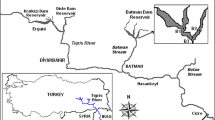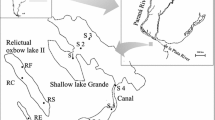Abstract
Summer phytoplankton assemblages are described and characterised according to their prevalence in a series of hard-water reservoirs of eastern Spain that had been classified in trophic categories on OECD criteria. Distribution patterns of phytoplankton species were ordinated statistically by principal components analysis (PCA). The first component was strongly related to trophic gradient and it particularly discriminated the eutrophic and hypertrophic reservoirs. The second component segregated life-forms, so that (1), on the oligo-mesotrophic side, large dinoflagellates were separated from small centric diatoms, unicellular chrysophytes and filamentous ullotrichales and, on the eu-hypertrophic side (2), colonial greens and large desmids were separated from unicellular volvocales and small centric diatoms.
The large differences between eutrophic and hypertrophic reservoirs were also clearly identified in a second PCA, in which physical and chemical factors were used with the principal components solved from the phytoplankton data. From these results, a new trophic category was discerned, for which we propose the name ‘holotrophic’. This category applies to water bodies having the following main features: (1) concentrations of chorophyll, total P and total N in the range of the hypertrophic systems, but with much higher concentrations of dissolved phosphorus and ammonia and (2) phytoplankton predominantly composed by unicellular green flagellates (Pteromonas, Chlamydomonas) and chlorococcales (Scenedesmus), without cyanobacterial blooms.
Similar content being viewed by others
References
Abdul-Hussein, M. M. & C. F. Mason, 1988. The phytoplankton community of a eutrophic reservoir. Hydrobiologia 169: 265–277.
Alvarez-Cobelas, M. & B. A. Jacobsen, 1992. Hypertrophic phytoplankton: an overview. Freshwat. Forum 2: 184–199.
APHA – AWWA – WEF, 1992. Standard methods for the examination of water and wastewater. 18th edition. American Public Health Association. Washington D.C.
Armengol, J., J. L. Riera & J. A. Morguí, 1991. Major ionic composition in the Spanish reservoirs. Verh. int. Ver. Limnol. 24: 1363–1366.
Barone, R. & L. Naselli Flores, 1990. Osservazioni sulle comunità planctonique dei laghi artificiali siciliani: relazioni diversità –biomassa. Naturalista sicil. 14 (suppl.): 35–48.
Barone, R. & L. Naselli Flores, 1994. Phytoplankton dynamics in a shallow, hypertrophic reservoir Lake Arancio, Sicily. Hydrobiologia 289: 199–214.
Estrada, M., 1975. Statistical consideration of some limnological parameters in Spanish reservoirs. Verh. int. Ver. Limnol. 19: 1849–1859.
Golterman, H. L., R. S. Clymo & M. A. M. Ohnstad, 1978. Methods for physical and chemical analysis of freshwaters. IBP Handbook no. 8. Blackwell Sci. Pub., Oxford, U.K.
Margalef, R., M. D. Planas, J. Armengol, A. Vidal, N. Prat, A. Guisset, J. Toja & M. Estrada, 1976. Limnología de los embalses españoles. Dirección General de Obras Hidráulicas. MOP. Madrid. Pub. 123, 422 pp.
Margalef, R., M. Mir, & M. Estrada, 1982. Phytoplankton composition and distribution as an expression of properties of reservoirs. Can. W. Res. J. 7: 26–50.
Mohammed, A. A., A. M. Ahmed & A. M. El-Otify, 1989. Field and laboratory studies on Nile phytoplankton in Egypt. IV Phytoplankton of Aswan High Dam Lake (Lake Nasser). Int. Revue ges. Hydrobiol. 74: 549–578.
Moss, B., 1973. The influence of environmental factors on the distribution of freshwater algae: experimental study. IV. Growth of test species in natural lake waters and conclusion. J. Ecol. 61: 193–211.
Naselli Flores, L. & R. Barone, 1994. Relationship between trophic state and plankton community structure in 21 Sicilian dam reservoirs. Hydrobiologia 275/276: 197–205.
Norusis, M. J., 1990. SPSS Base System User's Guide. SPSS Inc. Chicago, 520 pp.
OECD, 1982. Eutrophication of Waters. Monitoring, Assessment, and Control. OECD, Paris, 154 pp.
Ortiz Casas, J. L. & R. Peña, 1984. Applicability of the OECD eutrophication models to Spanish reservoirs. Verh. int. Ver. Limnol. 22: 1521–1535.
Reynolds, C. S., 1980. Phytoplankton assemblages and the periodicity in stratifying lake ecosystems. Holarct. Ecol. 3: 141–159.
Reynolds, C. S., 1982. Phytoplankton periodicity: its motivation, mechanisms and manipulation. Report of the Freshwater Biological Association 50: 60–75.
Reynolds, C. S., 1984a. Phytoplankton periodicity: the interactions of form, function and environmental variability. Freshwat. Biol. 14: 111–142.
Reynolds, C. S., 1984b. The ecology of freshwater phytoplankton. Cambridge University Press, 384 pp.
Reynolds, C. S., 1986. Experimental manipulations of the phytoplankton periodicity in large, limnetic enclosures in Blelham Tarn, English Lake District. Hydrobiologia 138: 43–64.
Reynolds, C. S., 1988. Functional morphology and the adaptative strategies of freshwater phytoplankton. In Sandgren, C. D. (ed), Growth and survival strategies of freshwater phytoplankton. Cambridge University Press: 388–433.
Riera, J. L., D. Jaume, J. De Manuel, J. A. Morgui & J. Armengol, 1992. Patterns of variation in the limnology of Spanish reservoirs: a regional study. Limnetica 8: 111–124.
Rojo, C. & M. Alvarez-Cobelas, 1993. Hypertrophic phytoplankton and the intermediate disturbance hypothesis. Hydrobiologia 249: 43–57.
Rott, E., 1981. Some results from phytoplankton counting intercalibrations. Schweiz. Z. Hydrol. 43: 34–62.
Sabater, S. & J. Nolla, 1991. Distribution patterns of phytoplankton in Spanish reservoirs: first results and comparison after fifteen years. Verh. int. Ver. Limnol. 24: 1371–1375.
Shapiro, J., 1989. Current beliefs regarding dominance by blue-greens: The case of the importance of CO2 and pH. Verh. int. Ver. Limnol. 24: 38–54.
Sommer, U., 1989. Nutrient status and nutrient competition of phytoplankton in a shallow, hypertrophic lake. Limnol. Oceanogr. 34: 1162–1173.
Utermöhl, H., 1958. Zur Vervollkommnung der quantitativen Phytoplankton-Methodik. Mitt. int. Ver. Theor. Angew. Limnol. 9: 38 pp.
Vegas Vilarrubia, T., 1994. Water chemistry of the Guri reservoir (rainy season 1989) – relationships between humic colour and aqueous iron and their limnological importance. Arch. Hydrobiol. 132: 69–94.
Rights and permissions
About this article
Cite this article
Dasí, M.J., Miracle, M.R., Camacho, A. et al. Summer phytoplankton assemblages across trophic gradients in hard-water reservoirs. Hydrobiologia 369, 27–43 (1998). https://doi.org/10.1023/A:1017051322293
Issue Date:
DOI: https://doi.org/10.1023/A:1017051322293




